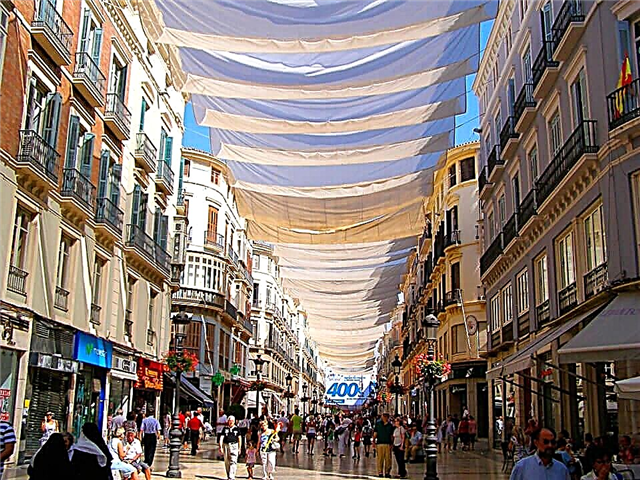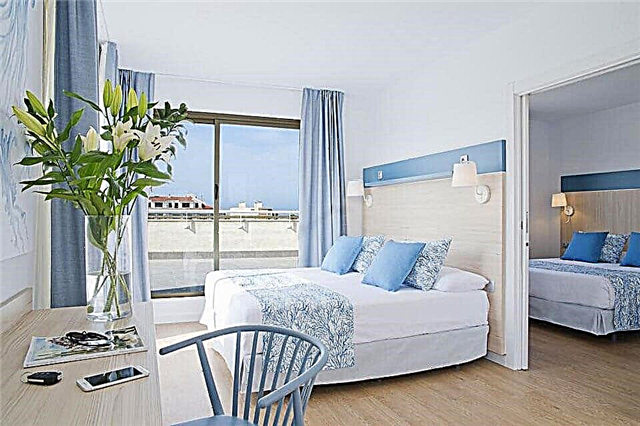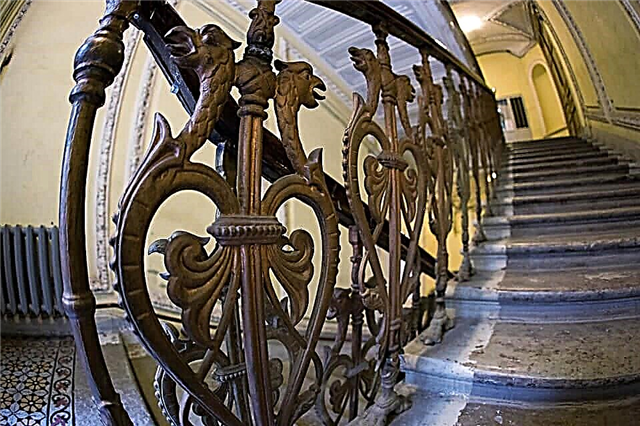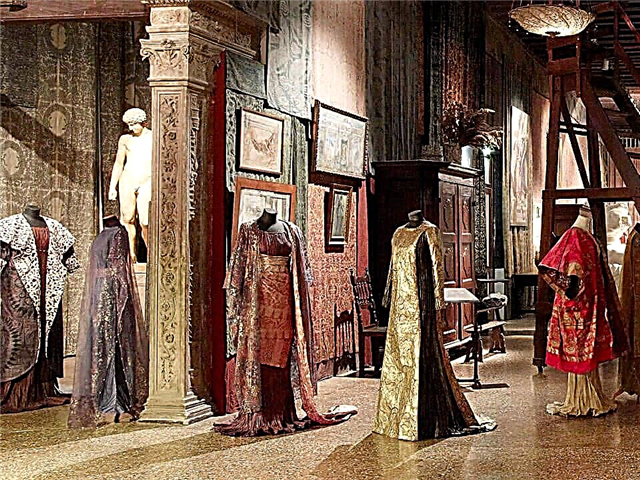It is not at all necessary to look for the inscription “Museum” on the buildings of Venice. The entire extraordinary city is a huge museum of palaces, churches, monuments, cathedrals, reflected in the numerous canals of the city, creating an atmosphere of mysterious infinity. It seems to be made up of thousands of architectural masterpieces hiding inimitable works of art. You can't see everything in one trip to Venice. It is necessary to correctly draw up a plan of acquaintance with the Museums of Venice, to collect as much preliminary information as possible. And then ancient Venice will become closer, more understandable.
The treasures of the city can be viewed by purchasing a map, which gives the possibility of a one-time visit to specific museums. You can take excursions, walk on your own, having previously booked a ticket to visit any sight of the city. Let's talk about the most interesting museums in Venice.
Academy Gallery

The attraction is considered the best art museum in Venice. Here is the most voluminous collection of paintings in Venice from the XIV to the XVIII centuries. It is located on the southern side of the Grand Canal of the Dorsoduro district at Campo della Carita 1050.
The decision to create the Academy of Arts was made in 1750. His goal was the desire to make Venice a place of artistic education, education of the country's population in the image of Rome, Florence, Milan, Bologna. The talented youth of Italy studied painting and architecture here. For the first time in the country, within the walls of the Academy, groups were created to train professional restorers.
The name of the Royal Academy of Fine Arts has been given to the landmark since 1807. In the 19th century, the school received the status of a museum. From this period, the funds of the museum began to increase, uniting in their reserves the works of all famous masters of Italy. Works by Titian, Giovanni Bellini, Carpaccio, Vittore are displayed in several buildings allocated for the museum.
These are the premises of an ancient monastery of the 16th century, the Church of Santa Maria della Carita. The main funds of the museum grew rapidly due to donations from patrons. Initially, all museum elements were housed in 5 halls. Now for the expositions of the museum there are 25 exhibition areas allocated.
The museum is open to visitors on the following working hours: Monday from 8.15 to 14.00. Tuesday - Sunday from 8.15 to 19.15. The Gallery is closed on public holidays. On Valentine's Day, there is a payment for two tickets for the price of one. All women can visit the Gallery without payment on March 8th. You can get there along the Grand Canal to the Ponte dell'Accademia stop.
Venice: Skip-the-Line St Mark's Cathedral Ticket
Opera La Fenice: skip-the-line ticket with audio guide
Short boat trip to Murano, Torcello and Burano
Venice: Shared Gondola Ride
Doge's Palace

A famous monument of the Italian Gothic of the 15th century, an important building in Venice adorns St. Mark's Square. It amazes with the unexpected beauty of architectural techniques. Since its original image of 1309 by Filippo Calendario, the building has served as the residence of the Doges. It hosted meetings of the Grand Council, the Senate, the Supreme Court, and the secret police of the state. Numerous offices, offices, services of the maritime department functioned.
The beauty of the facade, stairs, walls, ceiling, decorated with gilding, frescoes creates a stunning effect that attracts visitors. Now the palace houses the Museum, which has been open to tourists since 1923. You can see all the ceremonial halls, prison cells that resemble deep wells, listen to the history of creation, the purpose of the following places of the Palace:
Golden staircase. It was built in 1559, allowing the passage of important guests listed in the "Golden Book". The staircase is decorated with interesting gilded figures.
Ladder of the Giants. The most important events, for example, the wedding of the Doge, took place on the stairs, built of Carrara marble, decorated with majestic statues of Mars, Neptune. During the celebrations, the staircase became a throne.
Paper door. Through it you can go to the courtyard of the building, to the arched gallery of Foscari. The door is made in the form of a pointed arch, decorated with Gothic elements in the form of a winged lion, a statue of Justice. In ancient times, clerks worked here who filled out various documents for the townspeople.
Hall of the Great Council. It is considered the largest hall in the country. After reconstruction, you can see the throne of the Doge, the huge armchairs of six members of the Small Council, the surviving portraits of all the Doges. The entire wall is occupied by the famous painting "Paradise". It is considered the largest picture in the world. A beautiful view of the lagoon opens from the windows of the hall.
Election hall. Otherwise, it is called the hall of fate. It confirmed the verdicts, held elections for officials.
Compass room. Here the terrible decisions of the Inquisition were announced, and the Lion's Mouth was located for denunciations.
Council Room of Ten. It was the seat of a ten-member tribunal that conducted investigations into cases of state criminals under the leadership of the Doge. Prison cells were located above the hall.
You can also see the rooms of Scarlatti, Karta, the College, the Senate, and the Prison. For visits, the Palace is open daily from 8.30 to 19.00 (from April to November).
Address: Palazzo Ducale, San Marco 1, Venezia, Italy.
The Marciana Library

It is impossible not to notice the beautiful Renaissance building, decorated with arches, columns, sculptures. The treasures of the Venice National Library are hidden behind the openwork arcades of the walls. Thanks to the start-up capital in the form of a rich collection of books created by Cardinal Bessarion in 1469, gifts from aristocratic families, gifts from monasteries, the general fund of the library became the largest in Venice. Now on its shelves are stored about 13,000 manuscripts, 2,883 early printed books, 24055 editions of the 16th century, the era of the beginning of book printing.
More than a million of the first printed volumes contain the works of ancient scientists and philosophers (Aristotle, Euclid, Aeschylus) of great scientific value that have become a world heritage. Among them, 13 volumes containing hand-made anatomical illustrations donated in 1619 are considered invaluable treasures. 216 old manuscripts, transferred in 1734.
A collection of 360 manuscripts with the present testament of the famous Marco Polo, rare notes from old operas. It now houses one of the largest collections of classical texts in the world. In many ways, this was helped by the law of 1603, which ordered that a copy of any book published in Venice be provided to the library.
You can see beautiful bookcases, feel the atmosphere of secrets hidden behind the covers of old editions with a single ticket to the museums of San Marco.
The library is located at Piazzetta S. Marco, 7, 30124 Venezia. Open from 8.00 to 19.00 from Monday to Friday. The working hours of some library departments may be different.
Ca - Rezzonico

The modern Venice Museum of the 18th century is located in an old house inherited from the famous Rezzonico family. According to the traditions of the dialect of the country, the term Ka meant "house" or "kaza". There are many such palaces in Italy. Often they were erected according to the same type of shop for the sale of goods delivered through the channels. The main hall, where customers came to pick up the goods they brought, was on the ground floor. The owners' living quarters were set up on the second floor.
A servant lived on the top floor. The foreground of the building looked out onto the canal; there was a well in the courtyard. The end of the construction of the palace dates back to 1756. By this time, the expensive decoration of the building had been completed by the famous artists of Venice. Gradually, the palace turned into a rich museum with art exhibits displayed in a natural, historical setting. These are the famous paintings by Tiepolo, Giovanni Domenico, Francesco Guardi, Pietro Longhi.
On all three floors, objects that surrounded the life of wealthy Venetians in the 18th century are displayed. Now the halls of Tronny, Ballroom, Lazzarini, Receptions, Tiepolo have been restored and opened access to visitors. In them you can see beautiful carved furniture from expensive species of trees, crystal chandeliers, mirrors, ceiling frescoes, luxurious ornaments inherent in the current era.
You can get to the Museum, located at Dorsoduro, 3136, fondamenta Rezzonico by vaparetto route number 1, going along the Grand Canal. The stop is called Ca 'Rezzonico. From April to the end of October, the museum is open from 10 am to 6 pm.
Oriental Museum in Ca Pesaro

The Museum is located in the house of the noble Piezaro family, built by the architect Baldassare Longhena in the Venetian Baroque style in 1710. A snow-white, beautiful palace located in the historic site of Santa Croce. Since the beginning of the 20th century, it has housed a collection of paintings and sculptures of the 19th and 20th centuries, giving it the status of the International Gallery of Contemporary Art. The rich expositions include works by Chagall, Miro, Matisse, Klee, Klimt, Malyavin, and other famous masters.
The top floor houses the Museum of Oriental Arts. It exhibits items from China, Japan, Indonesia. Among them there are many interesting enamel and porcelain figurines, paintings, swords, daggers and other weapons.
Located at Santa Croce, 2070, fondamenta Ca'Pesaro. Opening hours from April to the end of October from 10 am to 6 pm. Monday is the day off.
Natural History Museum

In an old building, erected in the 13th century for representatives of a wealthy family of merchants, now visitors with children can find real wonders of nature for themselves. The exhibits of the skeletons of huge dinosaurs, which once roamed freely around our planet, cause an extraordinary delight, surprise.
The idea of combining scientific collections as the Venice Museum of Natural History originated in 1923. The empty palace has themed rooms dedicated to representatives of the local fauna and flora. Rich herbariums, collections of insects, minerals, found fossils, marine plants, animals are housed in spacious halls.
A library with scientific publications of the corresponding profile functions in the building. The huge aquarium is filled with almost all existing species of invertebrates, fish, revealing the ecosystem of the Adriatic. In the hall of ethnography you can get acquainted with the life, customs of the population of Venice. The Museum has a section of Earth Sciences, interesting sections Botanical, Zoological. There is a laboratory for the repair, restoration of damaged exhibits, preservation of fossils and mollusks.
Located at Santa Croce, 1730, Salizzada del Fondaco dei Turchi. The institution starts work at 10 am and ends at 6 pm. Closed on Monday.
Fortune Museum

The old palace of the Gothic style is considered the decoration of the San Marco quarter of Venice. Once the building of the city was the tallest. Until the end of the 19th century, the house belonged to the Pesaro family. Then it was bought by the artist, designer Mariano Fortuny, making it a place for the creation of amazing works. These were paintings, theater decorations, photographs, items of original textile design. All works became a legacy for the future museum, created in 1956, dedicated to Fortuny.
The collection of the museum consists of 150 paintings, photographs made in various ways of shooting. Elements based on complex lighting effects, collections of fabrics, costumes, ornaments, Renaissance velvet products designed by the artist. Models of long dresses made of pleated silk, designed by the master, are still popular at international auctions. The atmosphere, the charm of the era is felt with special force in the Museum.
Address: Museo Fortuny, San Marco, 3780. Open daily, except Tuesday weekends from 10 am to 6 pm.
Museum of the History of the Navy

The life story of Venice is associated with the sea. Its wealth, culture, traditions were formed through the use of sea routes, gifts of local nature. Numerous types of ships and sea vessels were built in the country. In the life of the Doges, a special place was occupied by floating palaces, where their events were held, for example, the ship "Buchintor", used for "betrothal to the sea" by the last ruler of Venice.
The boat, distinguished by rich gold decorations, original sculptures (only a small part of them have survived now), is considered the pride of the museum, founded in 1919. Here you can learn the history of the Venetian fleet, see a collection of unique exhibits.
Among them are ship models, originals of archival documents, weapons, awards, ancient uniforms, hats from all over the world, portraits of famous admirals, samples of torpedoes. The museum's cabinets contain an amazing collection of thousands of shells. The total number of exhibits exceeds 25 thousand.
The museum is located to the left of the Arsenal of Venice. A simple building with an anchor at the entrance has 5 floors, 42 exhibition halls, a pavilion of ships called the "Paddle Workshop". The largest ships are stored in it.
Address: Castello, 2148, campo San Biagio. Opening hours: Monday-Thursday from 8.45 am to 1.30 pm. On Friday, you can view the exhibit from 8.45 am to 5 pm. On Saturday, Sunday, open from 10 am to 5 pm.
Correr Museum

The story is connected with the name of the famous aristocrat Teodoro Correro. With his gift to the city in the form of a rich collection of paintings, valuable art exhibits, and his own house, the formation of the funds of the famous museum began, which occupied an area of 33 halls on three floors of the building. On its basis, since the period of 1830, permanent exhibitions have been created, reflecting the diversity of aspects of the life of the population at different times. Among them, the following exhibitions are of interest:
- 1.Exposition of the elements of the Correr Foundation. It includes interesting views of Venice from different historical times, documents, old clothes, coins, a monastery library.
- 2.Exposition of paintings of painting. Works by artists of the Venetian school of painting, the famous painting by Carpaccio "Two Venetians", Bellini's works "The Crucifixion", "Transfiguration", which are considered masterpieces of the 15th century.
- 3. Collection of the Risorgimento Museum. Rare exhibits form a true picture of the historical period of the 19th century in Italy. These are old documents, engravings, costumes related to the fall of the republic, the change in the borders of Italy.
Located in the building of the Prosecutor's Office of Piazza San Marco, opposite the cathedral. You can visit from 10 am to 7 pm during the period from April to the end of October. From November to March, the museum is open from 10 am to 5 pm.
Lace Museum

In 1981, on the island of Burano, located 9 km from Venice, an interesting museum was opened, combining exhibits that are considered a symbol of the country along with the famous gondolas. The works of the masters of the Venetian lace school, operating since 1872, were created on the basis of the ancient traditions of weaving amazing lace.
The preservation of knowledge of the unique business, the education of its followers became the task of the museum. The value of handmade lacemakers all over the world correlated with the price of gold. Now only in the museum you can see real Venetian lace, woven from gold and silver threads from the 16th to the 20th century.
Looking at the products, you begin to believe the ancient legend that the fisherman's wife came up with, creating a pattern that resembles seaweed. They made openwork patterns using a needle, not a hook, bobbins. By the way, on the top floor of the museum there is an exhibition of numerous tools used to create lace.
The collection contains a sample of lace made without a base and resembling a weightless spider web. The expositions are located on three floors of the building that served as a school of lacemakers at Piazza Galuppi, 187, 30142 Burano.
In summer, it works from 10 am to 6 pm. During the winter months, the working day becomes one hour shorter. You can get to the island by water tram vaparetto 42, 43, 41.
Peggy Guggenheim Collection

The museum, created by the efforts of the collector Peggy Guggenheim, is considered a popular landmark in Venice. Outside the walls of the palace, erected in the 18th century, exhibitions of paintings by contemporary artists were held for 30 years.
It was one of the pleasures of a wealthy heiress who appreciated, understood art, published magazines, and provided financial support to talented craftsmen. The bohemian life of the secular society of that time without Peggy's energy would be boring, uninteresting. She was the last member of the privileged society of Venice to be granted the right to have a gandola.
After her death in 1979, a collection of 300 paintings by famous artists of the 20th century became the property of the museum. In the future, the fund was replenished with gifts from wealthy families. Among the paintings from the collection of Peggy Guggenheim are works by Picasso, Dali, Kandinsky, Mondrian, etc.
Located in the Palazzo Venier dei Leoni, on the Grand Canal at Dorsoduro, 701, Calle San Cristoforo.
You can get acquainted with the exposition every day from 10 am to 6 pm. Closed on Tuesday.
Murano glass museum

The glory of the glass blowers of the island of Murano has been known since the distant 1290s. Fearing fires, the city authorities moved the fire hazardous production to the island of the Venetian lagoon. Kept in secret, the process of creating amazing glass figurines, various products, has been passed down through generations of glassblowers.
Unique technologies made it possible to create ultra-thin products from natural quartz crystals. Smalts (enameled glass), products with gold threads (aventurines), imitation of precious stones, colored glasses.
In the complex, created in 1851, you can not only see the masterpieces of Murano glass, but also get acquainted with the processes of its creation, listen to an interesting lecture on the history of glass blowing. Buy an original souvenir, vase, panel. Opens at 10 am, works until 6 pm.
Get to vaparetto 41, 42, 52, 51 from the train station.











